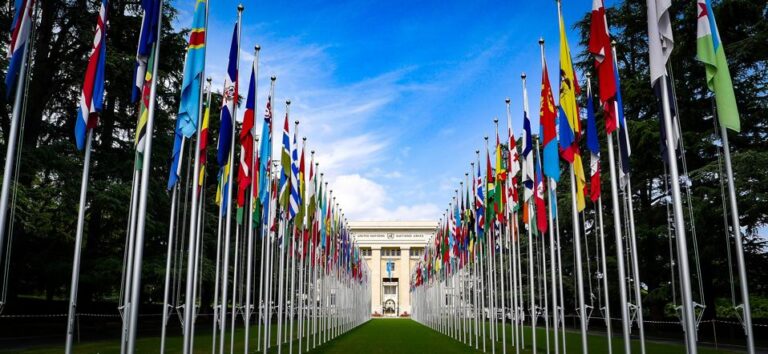Flag Draped Entrance to the United Nations Building in Geneva Switzerland
getty
Today, October 24, 2025, we mark the 80th anniversary of the United Nations. This milestone is not just a moment for retrospective applause but a critical inflection point. As we celebrate eight decades of global cooperation — a project born from the ashes of a world war — we stand in a hybrid tipping zone, caught between exponential technological acceleration and an accelerating decline in planetary health. The decisions we make now, as the last pre-Generative AI – GenAI – generation, carry immense opportunity and an unshakeable obligation to the world that follows: Generation GenAI.
The challenge is to ensure that the algorithmic infrastructure currently being built is one in which the next generation’s minds can evolve with freedom, fairness and a deep connection to the planet. We need human leadership for humane technology.
The Four Threats: A Crisis Of Agency And Ecology
The world is currently navigating a dangerous confluence of systemic crises, defining our hybrid tipping zone. These threats occur simultaneously and interwoven – with technological acceleration undermining the human capacity needed to tackle ecological collapse.
1. Technological Threat: Agency Decay
As sophisticated AI systems increasingly automate decision-making, we risk losing the ability and volition to act autonomously, and the very perception of that agency. The risk of agency decay is acute. It occurs when we outsource our thinking, eroding our capacity to think for ourselves, make value-based trade-offs, and exercise critical judgment. Without a deliberate effort to cultivate hybrid intelligence, we become passive consumers of an algorithmically-shaped reality.
2. Institutional Threat: AI Mainstreaming
Governments, corporations, and international bodies are rapidly deploying AI, often without the necessary ethical and governance frameworks in place. This AI mainstreaming is driven by efficiency metrics. But if we put quantity over quality, delivery over discernment we risk falling into the age-old technology trap of “garbage in, garbage out”. The result of the current trend is a scaling of risk and bias at the institutional level – AI is integrated before safeguards are established.
We still have a choice – to turn the dynamic toward “values in, values out”; yet the window of opportunity is closing, fast.
3. Geopolitical Threat: Race To AI Supremacy
The geopolitical competition to lead in AI development is creating a race for AI supremacy. This competition drives deployment speed over deliberative, human-centric planetary health attentive design, often bypassing essential ethical vetting, environmental concerns and global cooperation. It threatens to bifurcate the world along algorithmic lines, undermining the multilateral cooperation the UN was founded to foster.
4. Ecological Threat: Planetary Boundaries Breached
Simultaneously, the foundational health of our planet is in steady decline. The 2025 Planetary Health Check report confirms that seven of the nine planetary boundaries have now been breached, including climate change, biodiversity integrity, and, for the first time, ocean acidification. This irreversible damage to the ecosystem is the ultimate constraint on all human progress and technological ambition. Lets face it – we need the planet to survive and thrive, online and offline. It does not need us.
Four Approaches: Human-Centric Renewal
Technology is a means to an end, and that end must be determined by human beings. We must choose a VIVO logic — values in, values out — by fostering human capacity and intentionally building ethical infrastructure. The following four approaches are necessary to pivot out of the hybrid tipping zone.
1. The Goal: ProSocial AI
It is time to reorient AI development toward a clear human purpose: a hybrid society where everyone has a fair chance to fulfill their potential. Prosocial AI can serve as a catalyst to make that possible with AI systems that are tailored, trained, tested and targeted to bring out the best in and for people and planet. Moving forward this requires moving beyond minimizing harm to actively maximizing social good.
2. The Method: Hybrid Intelligence
To achieve prosocial AI, we must cultivate hybrid intelligence, which arises from the complementarity of natural and artificial intelligences. This symbiotic partnership is the only way to build and boost human agency while leveraging algorithmic scale. It’s about amplification, not replacement.
3. The Enabler: Double Literacy
The foundation of HI is double literacy:
- Human Literacy: A holistic understanding of self and society, people and planet — encompassing how we think and feel, interact and choose as human beings; as well as our shared values, history and the complex, living systems that sustain us.
- Algorithmic Literacy: A clear, working understanding of what, why and how AI systems function, including their inherent biases, risks and influence on human cognition and collective action.
Without Double Literacy, agency amid AI is impossible.
4. The Policy: Add Regenerative Intent
The global solution must be built from the ground up, nation by nation, by integrating a commitment to actively heal and renew into all policy. As the last pre-generative AI generative we are tasked to weave ‘regenerative intent’ into existing and future national AI and Ethics frameworks. This is a call to move beyond mere sustainability — which aims to maintain the status quo — to actively designing systems and technologies that contribute to the healing of people and planet.
A GLOCAL Takeaway
The urgency of this moment demands that we think and act in a GLOCAL way, uniting local action with global context.
The GLOACL Approach to Prosocial AI
Walther, 2025
Images are for reference only.Images and contents gathered automatic from google or 3rd party sources.All rights on the images and contents are with their legal original owners.

